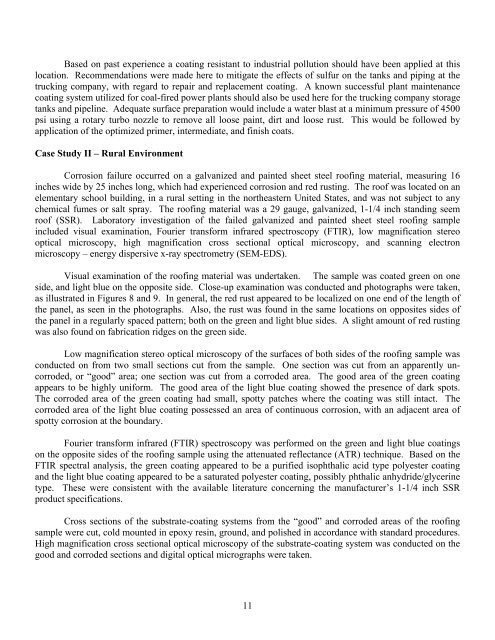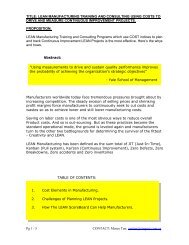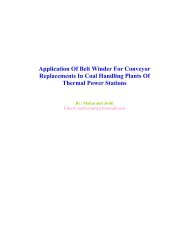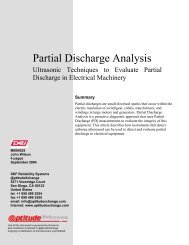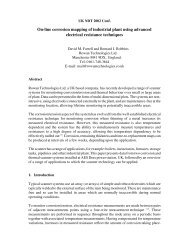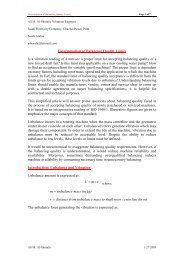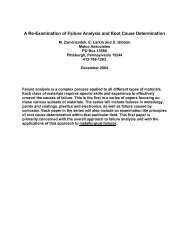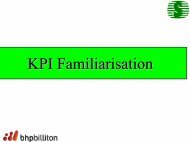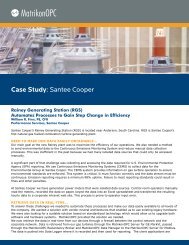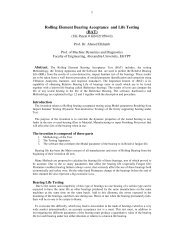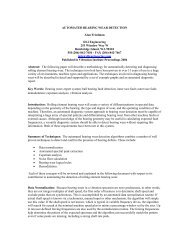Failure Analysis of Paints and Coatings - Plant Maintenance ...
Failure Analysis of Paints and Coatings - Plant Maintenance ...
Failure Analysis of Paints and Coatings - Plant Maintenance ...
You also want an ePaper? Increase the reach of your titles
YUMPU automatically turns print PDFs into web optimized ePapers that Google loves.
Based on past experience a coating resistant to industrial pollution should have been applied at thislocation. Recommendations were made here to mitigate the effects <strong>of</strong> sulfur on the tanks <strong>and</strong> piping at thetrucking company, with regard to repair <strong>and</strong> replacement coating. A known successful plant maintenancecoating system utilized for coal-fired power plants should also be used here for the trucking company storagetanks <strong>and</strong> pipeline. Adequate surface preparation would include a water blast at a minimum pressure <strong>of</strong> 4500psi using a rotary turbo nozzle to remove all loose paint, dirt <strong>and</strong> loose rust. This would be followed byapplication <strong>of</strong> the optimized primer, intermediate, <strong>and</strong> finish coats.Case Study II – Rural EnvironmentCorrosion failure occurred on a galvanized <strong>and</strong> painted sheet steel ro<strong>of</strong>ing material, measuring 16inches wide by 25 inches long, which had experienced corrosion <strong>and</strong> red rusting. The ro<strong>of</strong> was located on anelementary school building, in a rural setting in the northeastern United States, <strong>and</strong> was not subject to anychemical fumes or salt spray. The ro<strong>of</strong>ing material was a 29 gauge, galvanized, 1-1/4 inch st<strong>and</strong>ing seemro<strong>of</strong> (SSR). Laboratory investigation <strong>of</strong> the failed galvanized <strong>and</strong> painted sheet steel ro<strong>of</strong>ing sampleincluded visual examination, Fourier transform infrared spectroscopy (FTIR), low magnification stereooptical microscopy, high magnification cross sectional optical microscopy, <strong>and</strong> scanning electronmicroscopy – energy dispersive x-ray spectrometry (SEM-EDS).Visual examination <strong>of</strong> the ro<strong>of</strong>ing material was undertaken. The sample was coated green on oneside, <strong>and</strong> light blue on the opposite side. Close-up examination was conducted <strong>and</strong> photographs were taken,as illustrated in Figures 8 <strong>and</strong> 9. In general, the red rust appeared to be localized on one end <strong>of</strong> the length <strong>of</strong>the panel, as seen in the photographs. Also, the rust was found in the same locations on opposites sides <strong>of</strong>the panel in a regularly spaced pattern; both on the green <strong>and</strong> light blue sides. A slight amount <strong>of</strong> red rustingwas also found on fabrication ridges on the green side.Low magnification stereo optical microscopy <strong>of</strong> the surfaces <strong>of</strong> both sides <strong>of</strong> the ro<strong>of</strong>ing sample wasconducted on from two small sections cut from the sample. One section was cut from an apparently uncorroded,or “good” area; one section was cut from a corroded area. The good area <strong>of</strong> the green coatingappears to be highly uniform. The good area <strong>of</strong> the light blue coating showed the presence <strong>of</strong> dark spots.The corroded area <strong>of</strong> the green coating had small, spotty patches where the coating was still intact. Thecorroded area <strong>of</strong> the light blue coating possessed an area <strong>of</strong> continuous corrosion, with an adjacent area <strong>of</strong>spotty corrosion at the boundary.Fourier transform infrared (FTIR) spectroscopy was performed on the green <strong>and</strong> light blue coatingson the opposite sides <strong>of</strong> the ro<strong>of</strong>ing sample using the attenuated reflectance (ATR) technique. Based on theFTIR spectral analysis, the green coating appeared to be a purified isophthalic acid type polyester coating<strong>and</strong> the light blue coating appeared to be a saturated polyester coating, possibly phthalic anhydride/glycerinetype. These were consistent with the available literature concerning the manufacturer’s 1-1/4 inch SSRproduct specifications.Cross sections <strong>of</strong> the substrate-coating systems from the “good” <strong>and</strong> corroded areas <strong>of</strong> the ro<strong>of</strong>ingsample were cut, cold mounted in epoxy resin, ground, <strong>and</strong> polished in accordance with st<strong>and</strong>ard procedures.High magnification cross sectional optical microscopy <strong>of</strong> the substrate-coating system was conducted on thegood <strong>and</strong> corroded sections <strong>and</strong> digital optical micrographs were taken.11


